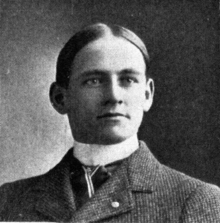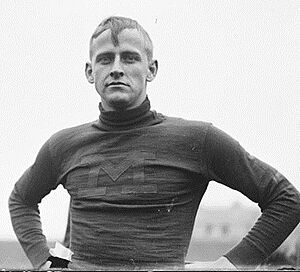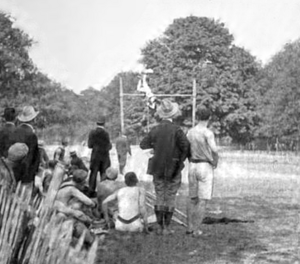Charles Dvorak facts for kids

Charles Dvorak from 1901 Michiganensian
|
|||||||||||||||||
| Personal information | |||||||||||||||||
|---|---|---|---|---|---|---|---|---|---|---|---|---|---|---|---|---|---|
| Full name | Charles Edward Dvorak | ||||||||||||||||
| Born | November 27, 1878 Chicago, Illinois, U.S. |
||||||||||||||||
| Died | December 18, 1969 (aged 91) Seattle, Washington, U.S. |
||||||||||||||||
| Sport | |||||||||||||||||
| Sport | Track and field | ||||||||||||||||
| Event(s) | Pole vault | ||||||||||||||||
| College team | University of Michigan | ||||||||||||||||
| Club | Chicago Athletic Association | ||||||||||||||||
|
Medal record
|
|||||||||||||||||
Charles Edward Dvorak (born November 27, 1878 – died December 18, 1969) was an American track and field athlete. He was famous for his skill in the pole vault. Charles went to the University of Michigan and competed for their track team from 1900 to 1904.
He took part in the 1900 Summer Olympics in Paris, where he was expected to win the pole vault. However, he missed the main event due to a misunderstanding about the schedule. He later won an unofficial silver medal in a special competition. In 1903, he set a world record in the pole vault by jumping 11 feet, 11 inches. Charles Dvorak then won the gold medal in the pole vault at the 1904 Summer Olympics. After his sports career, he became a high school coach in Seattle, Washington. He passed away in 1969 at 91 years old.
Contents
Early Life and Beginnings
Charles Dvorak was born in Chicago in 1878. His parents were Frank E. and Antoinette Dvorak. He attended the Lewis Institute in Chicago. Experts believe Dvorak was one of the first American athletes of Czech background to become very successful in sports.
Michigan University Years
Around 1898, Dvorak started studying at the University of Michigan. During his six years there, he was the captain of the track team. He also helped edit the university newspaper.
Before Michigan, Dvorak could pole vault about 9 feet, 6 inches. At Michigan, he worked with track coach Keene Fitzpatrick. Coach Fitzpatrick is known for creating modern pole-vaulting techniques. He taught Dvorak to hold the pole with his hands closer together. This new method helped Dvorak jump much higher.
In 1901, Dvorak won his first Western Conference pole vault championship. He jumped 11 feet, 6 inches. He earned his first degree in 1901 and later a law degree in 1904. Dvorak was part of four winning track teams from 1901 to 1904. He was the conference pole vault champion in 1901 and 1903. In 1903, he jumped 11 feet, 9 inches, setting a new record for college athletes.
In May 1903, Dvorak set a world record in the pole vault. He cleared 11 feet, 11 inches. People said he often jumped over 12 feet during practice!
1900 Summer Olympics in Paris
In 1900, money was raised to send Dvorak and other Michigan athletes to the 1900 Summer Olympics in Paris. In Paris, Dvorak missed the pole vault finals. This happened because of a problem with the schedule. Some events were planned for a Sunday. Many American athletes did not want to compete on Sunday.
Dvorak and another athlete, Bascom Johnson, went to the competition area. Officials told them the event was moved. But the officials changed their minds later. The pole vault happened after Dvorak and Johnson had left. Irving Baxter won the main competition. Because of the confusion, a special, unofficial competition was held. Dvorak won a silver medal in this special event. He jumped 11 feet, 1¾ inches.
Coach Fitzpatrick praised the American athletes when they returned. He also criticized the Paris officials for holding events on a Sunday.
Using the Bamboo Pole
Charles Dvorak is also known for being one of the first pole vaulters to use a bamboo pole. Before this, athletes used heavier poles made of wood like ash or hickory. He first tried a bamboo pole at the 1900 Summer Olympics. His own hickory pole broke during practice.
After his pole broke, Dvorak borrowed a light bamboo pole from a Danish athlete. He used it to finish the unofficial competition. His coach, Keene Fitzpatrick, thought Dvorak could have jumped even higher if he had used his usual pole. Dvorak used a bamboo pole for about a year. However, he went back to his old pole when he broke the world record in May 1903.
In 1963, when Dvorak was 84, Life magazine interviewed him. They asked about the new fiberglass poles that were becoming popular. Dvorak remembered how people talked when bamboo poles were first used. He said he didn't understand "what all the hollering is about" regarding the new fiberglass poles.
1904 Summer Olympics in St. Louis
Dvorak returned to the Olympics as part of the United States team at the 1904 Summer Olympics in St. Louis. On September 3, 1904, Dvorak won the gold medal. He jumped 11 feet, 6 inches. No other vaulter jumped higher than 11 feet. This jump set a new Olympic record!
A newspaper report described his win: "There was an unusually fine field in the pole vault contest. Five men broke the Olympic record before the event narrowed down to the final jumps, with three men eligible. Charles E. Dvorak of the C.A.A. then demonstrated his class, and from the 11-foot mark he competed alone... Dvorak's best was 11 feet 6 inches breaking the Olympic record..."
Life After Sports
After he stopped competing, Dvorak worked for over 35 years. He was a lawyer, a farmer, and a teacher. He also coached sports teams.
Coaching Career
In 1905, he coached the track team at Armour Institute in Chicago. In 1908, he became the athletic director and track coach at the University of Idaho.
In 1920, Dvorak moved to Seattle, Washington. He was hired as the coach for all sports teams at Franklin High School. He coached football there in 1920 and 1921. He coached a famous African-American athlete named Brice Taylor.
By 1925, Dvorak moved to Roosevelt High School in Seattle. He coached football, basketball, and track there for many years. He coached football for 15 years, with a record of 42 wins, 27 losses, and 18 ties. In 1934, Dvorak stopped coaching football to focus on basketball and track. He continued teaching and coaching at Roosevelt High School until at least 1941.
Later Life and Honors
Charles Dvorak passed away in 1969 when he was 91 years old. He lived in Seattle.
In 2008, Charles Dvorak was honored after his death. He was added to the Michigan Track and Field Hall of Fame.




